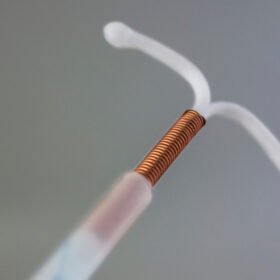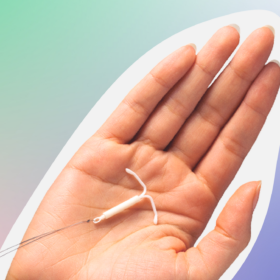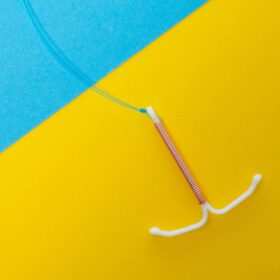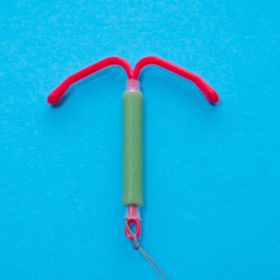
How do I check my coil threads?
In this article
What's the lowdown?
After you’ve had the coil fitted you should check the threads four weeks after.
You should feel two thin threads coming down into the vagina from the cervix.
You may not be able to easily identify 2 separate threads and that’s fine. These soften over time and might feel a bit like dental floss.
If you can’t feel your threads, you should call your GP or local sexual health service.
You should NOT be able to feel the plastic part of the coil which would feel like a matchstick coming down into your cervix. If this happens, please get in touch with a healthcare professional.
Coils are becoming ever more popular, and we love them at The Lowdown. Despite an inconvenient fitting procedure, the IUS and IUD are the most highly rated contraception methods by our users, so we expect even more of you to be taking the plunge in the future.
Why should I check my coil threads?
Coils (including the Mirena, copper and other IUS/IUD brands) are fab for many reasons, including because they can stay in place for anywhere between 3-10 years. Over this time, you are advised to check in with your coil every so often to make sure there are no problems. Part of this is monitoring for any new symptoms, the other is checking the coil threads. This is important to recognise if your coil has fallen out (expulsion) or moved.
Expulsion can happen in up to 1 in 20 women, most commonly within the first 3 months after fitting, or sometimes up to a year. The coil can also move up or down, lessening it’s contraceptive effect, and even perforate (make a hole) through the wall of the uterus. This is rare, but can happen in about 1 in 1000 coil fittings.
Feeling your coil threads is therefore a really important way to check your coil and get to know your body. It really isn’t that bad and only similar to inserting a tampon or menstrual cup. Here is our ‘how to guide’.
When should I check?
After you’ve had the coil fitted (and we hope you’ve had a comfortable experience!) you should check the threads 4 weeks after.
The most common time for a coil to come out is within the first 3 months after fitting and after a period. So we advise you to check the threads every 4 weeks which correlates to after a period. You don’t need a healthcare professional to do this, as you can check your threads yourself.
How to check coil threads
To feel for coil threads, get into a comfortable position similar to how you would insert a tampon or menstrual cup.
Use your 2nd or 3rd finger and pop it inside your vagina. You’re trying to feel your cervix which is smooth and firm, and feels just like the tip of your nose. From the cervix you should feel 2 thin threads coming down into the vagina. You may not be able to easily identify 2 separate threads and that’s fine. These soften over time and might feel a bit like dental floss.
What if they are longer or shorter?
Official guidance doesn’t mention whether longer or shorter strings warrants a trip to the doctors but many practitioners advise to look out for this. In our experience, threads can change slightly from month to month as the womb and cervix are mobile within the pelvis. We also know that coil threads can easily wind up within the cervical canal itself which can explain shortening of threads. However, if there is a drastic change in the length of your threads OR any other symptoms, you might want to get the coil position checked out.
What other symptoms should I be looking for?
You should NOT be able to feel the plastic part of the coil which would feel like a matchstick coming down into your cervix. Neither should your partner during sex. If you can, this could be a “partial expulsion” where the coil has come down from the womb into the cervical canal.
In SOME women, this will still act as contraception but small research studies have shown it may not be not as effective if the coil has moved 2cm or more away from the top of the uterus.
Other signs of a coil that has moved or come out include:
- Pelvic and lower tummy pain
- A sudden change in your bleeding eg. you have had no periods for 3 years then suddenly start bleeding
- A change in your vaginal discharge to a strange colour or smell (this is a sign of infection which needs identifying and treating quickly)
What do I do if I can’t feel my threads?
If you can’t feel your threads or have any of the symptoms above, you should call your GP or local sexual health service. Before you are seen for an examination, discuss with your doctor if you might need emergency contraception and use another form of contraception until you are seen.
When you are examined, the doctor will perform a speculum examination (like during a smear test) to look for your threads and check for any other problems. It is possible to use a device to pull the threads back down into place if they have moved inside the cervix. If the threads can’t be seen, the next step is to arrange an ultrasound and provide you with different contraception to keep you protected from pregnancy. If the ultrasound shows the coil isn’t in the right position, your healthcare practitioner will discuss the next steps for removal or replacement of the coil. If the coil is in the correct position you can continue to use it for contraception.
If you’ve experienced any of the above, don’t forget to leave us a review to share with other users!

Our medical review process
This article has been medically reviewed for factual and up to date information by a Lowdown doctor.







